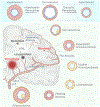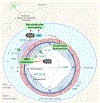Hypertension, Neurodegeneration, and Cognitive Decline
- PMID: 38426329
- PMCID: PMC11023809
- DOI: 10.1161/HYPERTENSIONAHA.123.21356
Hypertension, Neurodegeneration, and Cognitive Decline
Abstract
Elevated blood pressure is a well-established risk factor for age-related cognitive decline. Long linked to cognitive impairment on vascular bases, increasing evidence suggests a potential association of hypertension with the neurodegenerative pathology underlying Alzheimer disease. Hypertension is well known to disrupt the structural and functional integrity of the cerebral vasculature. However, the mechanisms by which these alterations lead to brain damage, enhance Alzheimer pathology, and promote cognitive impairment remain to be established. Furthermore, critical questions concerning whether lowering blood pressure by antihypertensive medications prevents cognitive impairment have not been answered. Recent developments in neurovascular biology, brain imaging, and epidemiology, as well as new clinical trials, have provided insights into these critical issues. In particular, clinical and basic findings on the link between neurovascular dysfunction and the pathobiology of neurodegeneration have shed new light on the overlap between vascular and Alzheimer pathology. In this review, we will examine the progress made in the relationship between hypertension and cognitive impairment and, after a critical evaluation of the evidence, attempt to identify remaining knowledge gaps and future research directions that may advance our understanding of one of the leading health challenges of our time.
Keywords: Alzheimer disease; blood pressure; brain; hypertension; stroke.
Conflict of interest statement
Figures





Similar articles
-
Neurovascular and Cognitive Dysfunction in Hypertension.Circ Res. 2019 Mar 29;124(7):1025-1044. doi: 10.1161/CIRCRESAHA.118.313260. Circ Res. 2019. PMID: 30920929 Free PMC article. Review.
-
Hypertension, Neurovascular Dysfunction, and Cognitive Impairment.Hypertension. 2023 Jan;80(1):22-34. doi: 10.1161/HYPERTENSIONAHA.122.18085. Epub 2022 Sep 21. Hypertension. 2023. PMID: 36129176 Free PMC article. Review.
-
Basic Mechanisms of Brain Injury and Cognitive Decline in Hypertension.Hypertension. 2024 Jan;81(1):34-44. doi: 10.1161/HYPERTENSIONAHA.123.19939. Epub 2023 Sep 21. Hypertension. 2024. PMID: 37732479 Free PMC article. Review.
-
Vascular contributions to cognitive impairment and dementia: a statement for healthcare professionals from the american heart association/american stroke association.Stroke. 2011 Sep;42(9):2672-713. doi: 10.1161/STR.0b013e3182299496. Epub 2011 Jul 21. Stroke. 2011. PMID: 21778438 Free PMC article. Review.
-
Impact of Hypertension on Cognitive Function: A Scientific Statement From the American Heart Association.Hypertension. 2016 Dec;68(6):e67-e94. doi: 10.1161/HYP.0000000000000053. Epub 2016 Oct 10. Hypertension. 2016. PMID: 27977393 Free PMC article. Review.
Cited by
-
Vascular Impairment, Muscle Atrophy, and Cognitive Decline: Critical Age-Related Conditions.Biomedicines. 2024 Sep 13;12(9):2096. doi: 10.3390/biomedicines12092096. Biomedicines. 2024. PMID: 39335609 Free PMC article. Review.
-
Hypertension and cognitive impairment among older persons in rural Northern Uganda: a cross-sectional study.BMC Geriatr. 2025 Jun 3;25(1):403. doi: 10.1186/s12877-025-06057-7. BMC Geriatr. 2025. PMID: 40461987 Free PMC article.
-
Blood pressure and the brain: the conundrum of hypertension and dementia.Cardiovasc Res. 2025 Apr 8;120(18):2360-2372. doi: 10.1093/cvr/cvaf010. Cardiovasc Res. 2025. PMID: 40084805 Free PMC article. Review.
-
Increased luminal pressure in brain capillaries drives TRPC3-dependent depolarization and constriction of transitional pericytes.Sci Signal. 2025 Apr 29;18(884):eads1903. doi: 10.1126/scisignal.ads1903. Epub 2025 Apr 29. Sci Signal. 2025. PMID: 40299956 Free PMC article.
-
A scoping review of neuromodulation techniques for controlling blood pressure: what are the ups and downs to this approach?Bioelectron Med. 2025 Aug 15;11(1):19. doi: 10.1186/s42234-025-00181-w. Bioelectron Med. 2025. PMID: 40814063 Free PMC article. Review.
References
-
- Swan GE, DeCarli C, Miller BL, et al. Association of midlife blood pressure to late-life cognitive decline and brain morphology. Neurology. 1998;51(4):986–983. - PubMed
-
- Kety SS, Hafkenschiel JH. The blood flow, vascular resistance, and oxygen consumption of the brain in essential hypertension. The Journal of clinical investigation. 1948;27(4):511–514 - PubMed
-
- Leopold IH, Kety SS. Correlation of the cerebrovascular resistance and the grade of hypertensive retinal findings. American journal of ophthalmology. 1949;32(3):365–368. - PubMed
Publication types
MeSH terms
Substances
Grants and funding
LinkOut - more resources
Full Text Sources
Medical

